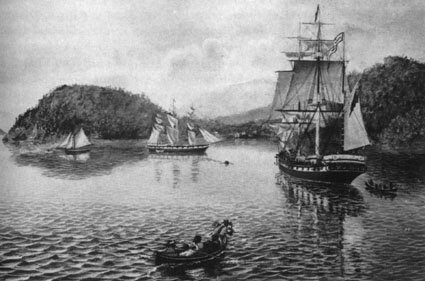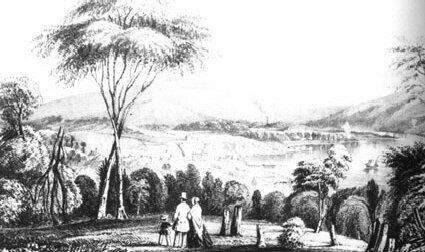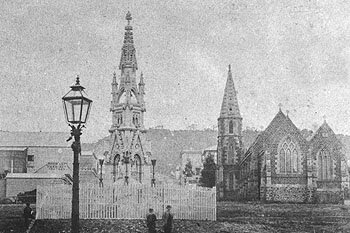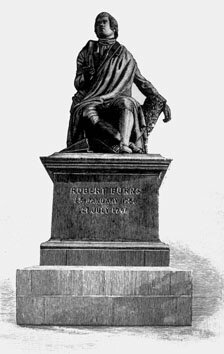|
|
|
|
|
|
|
|
|
|
|
The Settlement of 'New Edinburgh' - 'Dunedin'
|
Short history of the settlement by the Scottish of Dunedin
|
|
Compiled and written by: Brian Nicholls
With thanks to the "Hocken Library" for the use of the historic photo's
|
|
The 'John Wickliffe' and the 'Philip Laing' landed with the first settlers in 'Dunedin' in 1848.
|
|
|
 |
|
|
The 'John Wickliffe' and the 'Philip Laing' with the first settlers landing in 'Dunedin
|
|
|
|
|
|
It was the end of a period of intense activity, both at 'Home' and in New Zealand. But not entirely the end - the people working in Dunedin learnt only at the last minute that the settler ships would soon be there, so there was nothing much for the new arrivals to live in when they arrived.
The first organised European settlements of New Zealand had been organised by the New Zealand Company, under EG Wakefield, in 1839 - 1840, at Wellington, and around that Central area.
|
|
|
It was Wakefield's idea of the 'class settlement' (transposing a cross-section of the Old Country to NZ, from the labouring peasant to the capitalist) which inspired further settler movements in Britain, including in Scotland, where it at first centered around George Rennie, MP. He, in 1842, first proposed the establishment of a Scottish settlement:
|
|
|
|
'We shall found a New Edinburgh at the Antipodes that shall one day rival the old', he predicted. It would be a 'class settlement' all right, but one founded upon the 'Free Church'. Which is where Rennie eventually bowed out.
The reins were enthusiastically taken over by the future 'leader' of the new town, Captain William Cargill, who had fought in the Peninsula War, and who was now in his sixties. His 'Free Church' religious organizer was to be the Rev Thomas Burns, nephew of the bard, who had forsaken the Established Church after the 1843 Disruption. Although the problems in the way were mighty, there were also circumstances favourable - it was 'the hungry forties', landlordism was stripping the Highlands, the people needed fresh beginnings, and NZ was one of the chosen lands.
|
|
|
|
|
|
 |
|
|
Dunedin from "Little Paisley"
|
|
|
|
A Lay Association of the Free Church of Scotland for the NZ settlement was established, and they entered upon an arrangement with the NZ Company: the Co would make available 144,600 acres of land, divided into 2,400 properties.
- Town allotment 1/4 acre
- Suburban allotment 10 acres
- Rural allotment 50 acres
The cost would be 2 pounds per acre. The direction was obviously to make people town-dwellers, and also give them a start as farmers. Of course, this meant the NZ Co in NZ had to get things going. A priority had been to find a place for people to settle in the South Island. NZ Co surveyors inspected areas as prospects, one not liking the Otago site at all. Edward Shortland, the government's Protector of Aborigines, with local Maori guides, entered the Harbour, proceeding to the upper reaches, then over a period of days walked what was to become the "Otago Block". (It is probable that the word 'Otago' came from the Southern Maori pronunciation of the village at the Heads, 'Otakou', which had also been a whaling station, now abandoned.) They came to the hills over-looking a hilly and heavily-wooded harbour. This was the area that Frederick Tuckett, commissioned by Wakefield, came to consider in 1844. He had been told to find a site for settlement, initially Banks Peninsula, in what was to become Canterbury. The site was to be called 'New Edinburgh'. Tuckett surveyed the South Island's East coast, looking for useful harbours, on and off the chartered 'Deborah', walking with, or without, local guides. He tried Port Cooper (Lyttelton), didn't like it, went to Otago, walking the last miles overland, at that time a very rough trip. He found the 'Deborah' waiting for him, in the bay ever since called after the little vessel. He and his team of surveyors (Barnicoat and Davidson) walked the territory and came back, minds made up. On such trips is history set up. The local Maori were now involved: the land had to be bought, and the locals wanted a high price. Wakefield came down from Wellington with Government officials, and distributed 2,400 pounds in cash to the chiefs for disbursement, and four-penny pieces into out-thrust hands. It was a very large block of land, from North of the Harbour, right down to the Molyneux (now Clutha) River, and inland by several miles.
Surveying began, and the movement to gather financial backers, capitalists, and other settlers, began in Scotland. It could have flown, but the plan suffered set-backs, amongst which, the NZ Co fell into financial difficulties. Everything slowed down, Tuckett returned to England, those NZ settlers who came to the future city site to help with preparations (including setting up an hotel!) languished in hope.
|
|
|
 |
|
|
Octagon with Cargills Monument
|
|
|
|
|
|
Finally, the surveyors came back in 1846, led by 25-year-old Charles Kettle, to lay out the site. He had spent time in Edinburgh recently, and this knowledge enabled him to reproduce some of its characteristics and names in the new Edinburgh of the South. (In order to do this, of course, he frequently had to ignore the fact that straight street lines, though pretty on paper, have to ignore the sometimes near-vertical slopes of the future town's hills, and the many areas of swamp on the flat.) He brought with him a new wife, 11 surveyors and 25 labourers.
|
|
|
By the end of 1846 the pegs were being established. At that time, the sea covered much of the level ground, the swamps were fed from descending streams, and what was to be the principal street (Princes St through the Octagon to George St) was cut in two by a steep hill.
|
|
|
|
Of course, it wasn't Kettle's task to make the streets, just lay them out! Rennie's plan had been to have builders and labourers follow behind, but he was gone from the Lay Association in Scotland. To add to the difficulties of preparation, communications were so slow between the UK and NZ, and Wellington and Otago, that Wakefield found out the impending departure of the two first ships just before they left, and the boat he sent to Otago with stores and building materials arrived not long before the settlers.
"Dunedin", instead of 'New Edinburgh', had been chosen as the name of the new town in the promised land. It was the Celtic form of 'Edinburgh', and was part of the movement against establishing 'new' cities which had been current, eg New York. The two ships had sailed separately, the 'John Wickliffe' leaving Gravesend on the 24th November, 1847, and the 'Philip Laing' leaving Greenock three days later. The former carried Captain Cargill, 97 emigrants and a large quantity of stores. A majority of her passengers were not Free Kirkers, but Church of England (showing how difficult it had been to sell the idea of leaving everything for a foreign land to enough Scots). The 'Philip Laing' was only a little boat (450 tons), carrying 247 passengers. In charge was the Rev Thomas Burns. It would be a voyage of 117 days, during which there was no land in sight! She finally arrived on the 15th April, 1848, three weeks after the 'John Wickliffe'.
Life on board the 'Philip Laing' was disciplined and ordered. The emigrants rose at 6.30 am, roll-call 7.30 am, then quarters cleaned. Breakfast followed, then morning worship at 10.30 am. There were 93 children under 14, so they had school at 11 am, under the supervision of the Schoolmaster, James Blackie. Lunch followed, then, after free-time, school was re-called at 4 pm. Steerage passengers had tea at 5.30 pm, the cabin party at 6.30 pm. Evening worship brought the day to a close. And weekly rations for the steerage passengers:
|
|
|
|
51/4 lbs hard ship's biscuits; 31/2 lbs flour; 1lb beef; 11/2 lbs prime mess pork; 1lb preserved meat; 1lb rice; 1lb barley; 1/2 lb raisins; 3 oz suet; 1 pint peas; 1 oz tea; 11/2 oz coffee; 3/4 lb sugar; 7 oz butter; 1/2 pint vinegar or pickles; 2 oz salt; 1/2 oz mustard; 21 quarts water; 31/2 pounds potatoes.
Steerage passengers had paid 16 guineas passage money, cabin passengers from 35 guineas upwards.The 'John Wickliffe' had arrived off the coast opposite Saddle Hill on the 21st March, and finally entered the Harbour, accompanied by Kettle and Richard Henry Driver, the 'pilot', on the 23rd. The women and children stayed for a time on board while the men made their way to the town site, hastening to erect barracks on the beach, a jetty, a store (although a lot of the cargo had to stay covered in tarpaulins on the beach for a time). While building went on, the men lived in the bush, or in tents. Thankfully the weather was settled. One labourer wrote: "If I had been in Scotland, I would have been dead. I lived several nights in the bush, but found no ill effects from it."
|
|
|
|
Two sets of barracks were eventually built, one for the Scottish, the other for the English colonists. The 'Philip Laing' barracks were much larger, and divided into three: married couples in the middle, unmarried men and women at separate ends. Partly pre-fabricated cottages had been brought out for the leaders, and these were erected. The first note for the new settlement was struck by Captain Cargill, the 'father' and leader, when he addressed a united meeting of his pioneers: "My friends, it is a fact that the eyes of the British Empire, and I may say of Europe and America, are upon us. The rulers of our great country have struck out a system of colonization on liberal and enlightened principles. And small as we now are, we are the pre-cursors of the first settlement which is to put that settlement to the test."
|
|
|
|
|
|
|
 |
|
|
"Robby Burns Statue" on Octagon
|
|
|
|
|
|
|
|
|
|
|